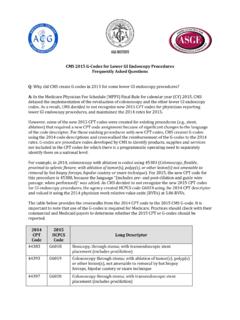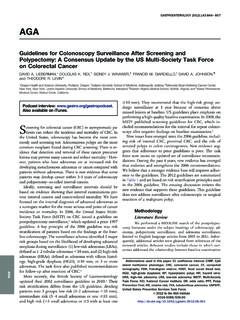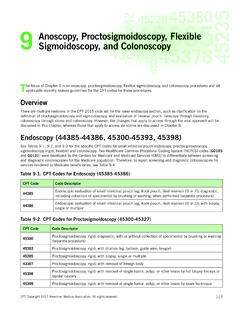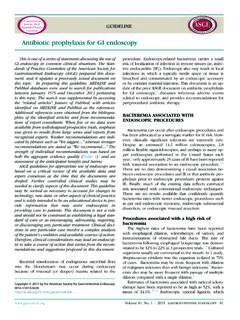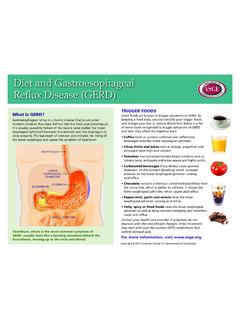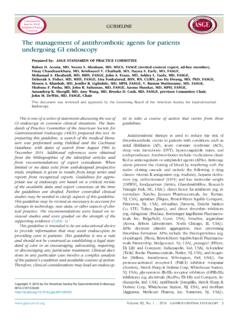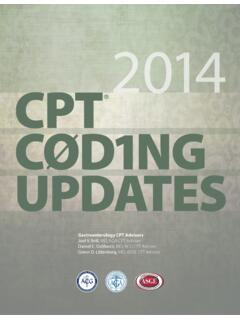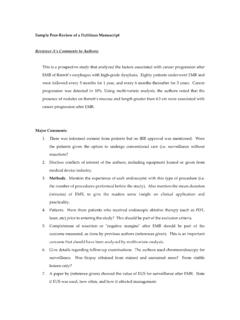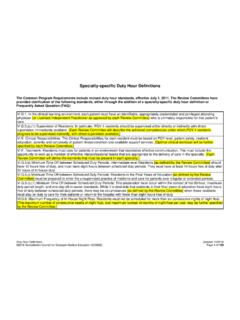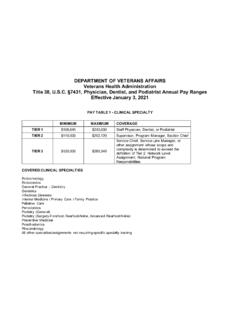Transcription of Infection control during GI endoscopy
1 Communicationfrom the ASGEQ uality AssuranceIn endoscopy CommitteeGUIDELINEI nfection control during GI endoscopyPrepared by: ASGE QUALITY ASSURANCE IN endoscopy COMMITTEEA udrey H. Calderwood, MD, Lukejohn W. Day, MD, V. Raman Muthusamy, MD, James Collins, RN,Ralph David Hambrick, III, RN, Andrew S. Brock, MD, Nalini M. Guda, MD, Jonathan M. Buscaglia, MD,Bret T. Petersen, MD, Navtej S. Buttar, MD, Lauren G. Khanna, MD, Vladimir M. Kushnir, MD,Aparna Repaka, MD, Nicolas A. Villa, MD, Glenn M. Eisen, MD, MPH, ChairThis document was reviewed and approved by the Governing Board of the American Society for GastrointestinalEndoscopy (ASGE).The Quality Assurance in endoscopy Committee of theAmerican Society for Gastrointestinal endoscopy (ASGE)updated and revised this document, which was originallyprepared by The Standards of Practice Committee of theASGE and was published in preparing thisguideline, a search of the medical literature wasperformed by using PubMed, supplemented by accessingthe related-articles feature of PubMed.
2 Additionalreferences were obtained from the bibliographies of theidentified articles and from recommendations of expertconsultants. When little or no data existed from well-designed prospective trials, emphasis was given toresults from large series and reports from recognizedexperts. Guidelines for appropriate use of endoscopyare based on a critical review of the available dataand expert consensus at the time the guidelines aredrafted. Further controlled clinical studies may beneeded to clarify aspects of this guideline. This guidelinemay be revised as necessary to account for changes intechnology, new data, or other aspects of guideline is intended to be an educational tool toprovide information that may assist endoscopists in deliv-ering care to patients.
3 This guideline is not a rule andshould not be construed as establishing a legal standardof care or as encouraging, advocating, requiring, ordiscouraging any particular treatment. Clinical deci-sions in any particular case involve a complex analysisof the patient s condition and available courses of , clinical considerations may lead an endoscop-ist to take a course of action that varies from of GI endoscopies are performed annuallythroughout the United States, and it is reassuring that docu-mented instances of infectious adverse events remain recent reports of infections with multidrug-resistantorganisms (MDRO) associated with duodenoscope usesuggest that prior assumptions regarding endoscopy -related Infection rates may be an underestimate, particularlyfor ERCP.
4 These outbreaks of Infection have led to areassessment of current Infection control transmission of infections may occur ifmicroorganisms are spread from patient to patient bycontaminated equipment or if microorganisms are spreadfrom the gut lumen during endoscopy through thebloodstream to susceptible organs, adjacent tissues, or pros-theses. Non-endoscopic transmission of infections withinendoscopy units also can occur if microorganisms aretransmitted from patients to endoscopy purpose of this document is to disseminate informa-tion and promote understanding of endoscopy -relatedtransmission of Infection in order to minimize its risk ofoccurrence. Circumstances in which an endoscopy -relatedinfection might occur are discussed, as are measures to pre-vent such Infection , including endoscope reprocessing andreprocessing failure, general Infection control , protection ofendoscopy personnel, and the importance of OF ENDOSCOPIC TRANSMISSIONOF INFECTIONOver the course of an endoscopic examination, theexternal surface and internal channels offlexible endo-scopes are exposed to bodyfluids and of these reusable instruments pose specialchallenges.
5 Flexible endoscopes are heat labile devicesand as such are not suitable for steam , reprocessing is achieved by mechanical anddetergent cleaning, followed by high-level disinfection(HLD), rinsing, and requests: Stephanie Kinnan, BA, ASGE, 3300 Woodcreek Drive,Downers Grove, IL 2018 by the American Society for Gastrointestinal Endoscopy0016-5107/$ , : 2018 GASTROINTESTINAL YMGE10866_proof 20 March 2018 9:49 pmStringent guidelines for the reprocessing offlexibleendoscopes were developed by the ASGE and the Societyfor Healthcare Epidemiology of America, who convenedwith representatives from physician, nursing, and infec-tion control organizations, industry leaders, and federaland state agencies. This conference resulted in the 2003publication of the Multisociety Guideline for Reprocessingof Flexible GI Endoscopes,3which was updated in 20114and in , in the absence of defectiveequipment, reported cases of transmission of infectionhave resulted from failure to adhere to these 2012, multiple and international medicalcenters have reported patient-to-patient transmission ofMDROs such as carbapenem-resistantEnterobacteri-aceae( CRE), without identifiable, overt breaches ofreprocessing of these organismshas been linked to the elevator channel endoscopes(duodenoscopes, linear array EUS scopes)
6 And primarilyattributed to persistent contamination of the elevatormechanism, the elevator cable, and the cable infectionsWhen clinically significant bacterial infections are trans-mitted endoscopically, they are often recognized becausetheir incubation periods are often short, and patients usu-ally develop overt clinical symptoms. However, cases oftransmission may be missed if the illness is subclinical orif symptoms are attributed to other factors associatedwith the procedure (issues related to the interventions per-formed or to sedation) or to other patient-specific condi-tions or events. Overall, although accurate data oninfection transmission rates are difficult to obtain becauseof the lack of a proper mechanism for reporting and calcu-lation of transmission rates, a summary of the availabledata, in the context of these reporting limitations, is pro-vided total of 84 cases of endoscopy -related transmission ofSalmonellaspecies between patients were reported be-tween 1974 and 1987,7-15but none have been reportedsince that time.
7 Overall, there have been rare reports ofendoscopic transmission ,17 Asrecently as 2011, 4 patients who underwent upper endos-copy were found to be infected with multidrug-resistantPseudomonas. Several potential causes for the transmis-sion were identified, including insufficient initial cleaning,shortening of immersion and brushing times, insufficientchannelflushing, and inadequate drying before addition to inadequate reprocessing of the endoscopeitself, the propensity for organism growth in moisture-rich environments is a common factor in facilitating trans-mission. In some instances, an unsterilized irrigation waterbottle attached to the endoscope was identified as a sourceof ,20A lack of cleaning and drying of the air-water and/or the elevator channels of duodenoscopesalso was implicated in some cases of transmission of automated endo-scope washer-dryers has been implicated in ,25,26 Recently, a strain ofPseudomonaswithreduced susceptibility to glutaraldehyde was few reports of endoscopic transmission ofHelico-bacter pyloriwere attributed to inadequate reprocessingof endoscopes and biopsy ,29Up to 61% of endo-scopes became contaminated after use in patients infectedwithH pylori,30but conventional cleaning and disinfectionof the instruments are highly effective in widespread application of standardizedreprocessing guidelines.
8 There were isolated reports ofendoscopic transmission of other enteric bacteria,includingKlebsiella,31 Enterobacter,17 Serratia, have been no reports of transmission of mycobac-teria by GI endoscopy . Current reprocessing guidelineswere shown to be adequate in eradicating mycobacteria,and to date there are no reports of transmission of myco-bacteria by GI , reprocessing underthe current guidelines was shown to inactivate biofilmand the spores ofClostridium difficileand otherbacteria,34,35and no cases of transmission ofC difficilehave been mentioned previously, transmission of MDROs,including CRE, via duodenoscopes, has been ,36-38 Unlike prior outbreaks of endoscope-transmitted infections , no recognized breaches of standardreprocessing protocol have been identified in outbreaks ofduodenoscope-associated CRE to date.
9 These transmis-sions seem to be related to difficult-to-clean or even sealedportions of these specific endoscopes, particularly theareas around the elevator regions of viral infectionsDocumentation of transmission of viral infections byendoscopy is more challenging, because these infectionshave a longer incubation period, and patients may beasymptomatic or minimally symptomatic. Thus, linkingtransmission of these infections to a previously performedprocedure may be difficult. Still, existing data suggest thatrisk of viral transmission via endoscopy is extremely low are rare reports of transmission ofhepatitis C in situations where lapses in HLD of endo-scopes occurred. Older case reports and epidemiologicstudies suggested an association between endoscopy andhepatitis C virus (HCV) seropositivity.
10 However, interpreta-tion of these reports is difficult because of a reliance onself-reporting of risk factors for HCV and other inherentbiases. In fact, the documented cases of HCV were allrelated to non-endoscopic transmission rather than directendoscopy-related transmission. Bronowicki et al39documented transmission of hepatitis C from an infectedpatient to 2 subsequent patients who underwentcolonoscopy with the same instrument. Transmission wasInfection control during GI endoscopy2 GASTROINTESTINAL ENDOSCOPYV olume-, : YMGE10866_proof 20 March 2018 9:49 pmoriginally attributed to 2 breaches in endoscopereprocessing: failure to clean the working channel of theendoscope manually before disinfection and failure tosterilize the biopsy forceps between patients.
